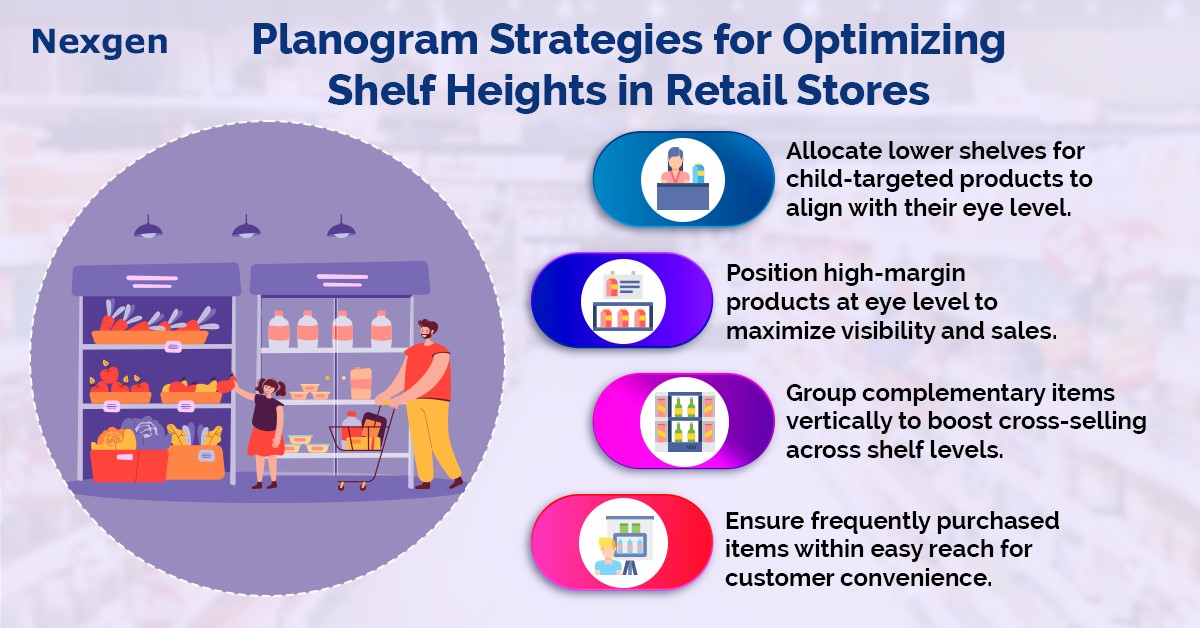In retail, understanding and catering to your customer’s' needs is crucial for driving sales and fostering loyalty. One often-overlooked aspect of store design is the strategic use of shelf heights. Utilizing shelf heights effectively through planograms is key to catering to diverse customer demographics and enhancing the shopping experience.
Planograms, which are visual diagrams that dictate the placement of products on shelves, allow retailers to strategically position items at optimal heights based on customer needs. For instance, placing popular or high-margin products at eye level ensures they capture the attention of adult shoppers, who typically browse at this height. Conversely, products aimed at children, like toys or snacks, should be positioned at lower levels for easy reach and visibility.
Understanding the Importance of Shelf Heights
Shelf heights play a significant role in merchandising and product visibility. The right height can make products more accessible, attract attention, and influence purchasing decisions. Now a days, most retailers rely on planogram experts to significantly enhance the utilization of shelf heights to drive sales. Planogram services involve creating detailed visual layouts that strategically position products at optimal heights based on customer needs and behaviors. Following are some key customer demographics to consider:
1. Children
For younger customers, placing popular items at lower heights is essential. Children’s products like toys or snacks should be easily reachable from a lower shelf to encourage interaction and increase the likelihood of purchase. Retailers can use bright colors and engaging displays at child-friendly heights to capture their attention and enhance their shopping experience.
2. Adults
Adults have a comfortable reach zone between waist and eye level. Therefore, placing high-demand items, promotions, or high-margin products at these heights ensures they are seen and considered more often using planograms. Ensure that frequently used products are within easy reach to avoid strain and enhance convenience.
3. Seniors
For older adults, lower shelves are more accessible. Avoid placing essential items or popular products on the top shelves, which may be difficult for seniors to reach comfortably. Use larger fonts and clear signage to make it easier for seniors to locate items without straining their eyes.
4. Height-restricted shoppers
Some shoppers might have physical limitations that make reaching high or low shelves challenging. Ensure that essential items are not placed on the top or bottom shelves, making them more accessible to everyone. Implement features such as lower shelves or easy-to-reach display units to accommodate various needs.
Strategies for Optimizing Shelf Heights

- Conduct customer research: Gather data on your customer demographics through surveys or in-store feedback. This information will help you understand the preferences and needs of your different customer groups. Analyze sales data to determine which products are popular among various demographics and adjust shelf heights accordingly.
- Flexible shelf systems:Use adjustable shelving units that can be repositioned to cater to different needs. This flexibility allows you to adapt the shelf heights based on seasonal promotions or changing product lines. Implement modular displays that can be customized to fit different product categories and customer preferences.
- Signage and labeling: Use clear and informative signage at varying heights to guide customers efficiently. Ensure labels are readable from different distances and heights. Incorporate interactive elements or digital displays at appropriate heights to engage customers and provide additional information about products.
- Regular evaluations: Regularly assess the effectiveness of your shelf height strategies. Pay attention to customer feedback, sales performance, and any difficulties faced by shoppers. Stay updated with retail trends and demographic changes to adjust your shelving strategies accordingly.
Overview of Nexgen Planogram Services
Nexgen offers store-specific planograms for clients that optimize sales and achieve category objectives. We create customized planograms for your business to ensure that these are better aligned with your goals and merchandising strategies. Our expertise in planogram automation helps us build planograms faster, better and consistently. Whether it is creating a planogram from scratch, or a typical reset, we have the knowledge, tools, and experience to get the job done for you.
Get Your Free Trial Now!